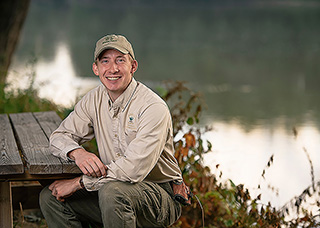October 27, 2016
Purdue student uses new technology to locate unknown piece of endangered Indiana prairie
 Ryan Schroeder, a natural resources and environmental science major who is in the Honors College and College of Agriculture, recently confirmed the location of an unknown piece of endangered Indiana prairie known as gravel hill prairie. (Purdue News Service/Charles Jischke)
Download image
Ryan Schroeder, a natural resources and environmental science major who is in the Honors College and College of Agriculture, recently confirmed the location of an unknown piece of endangered Indiana prairie known as gravel hill prairie. (Purdue News Service/Charles Jischke)
Download image
WEST LAFAYETTE, Ind. — Utilizing advances in soil-mapping technology, Purdue University student Ryan Schroeder has confirmed the location of an unknown piece of endangered Indiana prairie known as gravel hill prairie.
Gravel hill prairies are native grasslands on gravel deposits with relatively steep south, southwest or west facing slopes. There are less than 10 acres of gravel hill prairies remaining in the state. Conservation agencies are eager to identify them because they hold seven of the state's endangered plant species.
Schroeder, a natural resources and environmental science major who is in the Honors College and College of Agriculture, made the discovery Oct. 13 while doing fieldwork in Tippecanoe County with Derek Luchik, a Purdue graduate who is now working for The Nature Conservancy.
Under the guidance of Purdue agronomy professor Darrell Schulze and Songlin Fei, associate professor of forestry and natural resources, the senior from Greenfield, Indiana, has been using his skills with geographic information systems (GIS) and spatial analysis to help The Nature Conservancy, NICHES Land Trust and other researchers map likely locations of gravel hill prairie. The last systematic search for this rare type of natural area was in the 1980s.
"These newly discovered natural lands, which would not have been known without Ryan's work, are leading to NICHES outreach to the landowners," said Gus Nyberg, executive director of NICHES Land Trust. "We are hopeful this will create long-term protection of these lands through purchase or management agreements before these natural openings close and the prairie and open woodland species disappear."
According to the Department of Natural Resources, prairies are a longtime symbol of the Midwest, part of both Indiana's natural heritage and natural history. Much of Indiana's prairie, however, has been lost to drainage, urbanization, agriculture and the lack of natural fire. Fire helped maintain natural prairies by keeping trees out and stimulating the growth of prairie plants.
The newly discovered gravel hill prairie remnant is south of the Wabash River, near Evonik Corp.'s manufacturing facility. It sits on a steep bluff overlooking Wea Creek. There is a state-endangered plant species growing naturally there. Schroeder and his team will continue scouting potential gravel hill prairie locations this fall in Tippecanoe, Fountain and Warren counties.
"This discovery helps validate that the spatial model I have developed can find these important locations in a more efficient and cost-effective manner than what was done back in the 1980s," Schroeder said. "This remnant gives me hope that there are other remnants out there that have resisted the encroachment of forest and invasive species after all this time without the historical disturbance of fire."
Contact: Lindsay Perrault, Honors College communications manager, 765-427-1923, lindsayperrault@purdue.edu
Sources: Gus Nyberg, 765-423-1605, gnyberg@nicheslandtrust.org
Ryan Schroeder, 317-509-6401, schroe44@purdue.edu

